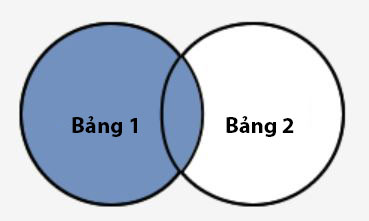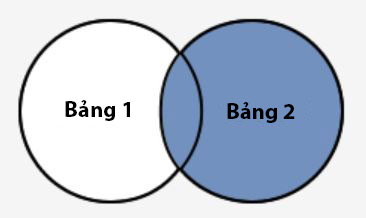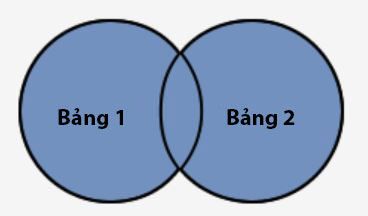JOIN in SQL Server
In SQL Server (Transact-SQL) JOIN is used to retrieve data from multiple tables, occurring when two or more tables are connected together in an SQL command. Here are 4 types of JOIN in SQL Server
- INNER JOIN - also known as simple connection form
- LEFT OUTER JOIN - or LEFT JOIN
- RIGHT OUTER JOIN - or RIGHT JOIN
- FULL OUTER JOIN - or FULL JOIN
Now let's look at the syntax, illustrations and examples to better understand JOIN in SQL Server.
INNER JOIN
Most likely you have already used INNER JOIN in certain commands. This is the most common type of connection, returning all rows from the tables when connection conditions are met.
INNER JOIN syntax
SELECT cot
FROM bang1
INNER JOIN bang2
ON bang1.cot = bang2.cot;

Illustrated image of INNER JOIN
The returned result is the common records between state1 and bang2.
Example INNER JOIN
SELECT nhacung.nhacung_id, nhacung.nhacung_ten, donhang.donhang_ngay
FROM nhacung
INNER JOIN donhang
ON nhacung.nhacung_id = donhang.nhacung_id;
The result returned in the above example is the row of information in the 'supplier' table and the 'order' table when the value of nhacung_id is equal to 2 tables.
Let's look at an example with specific data to better understand.
The nhacung table has 2 information fields: nhacung_id and nhacung_ten.
nhacung_id nhacung_ten 10000 IBM 10001 Hewlett Packard 10002 Microsoft 10003 NVIDIAThe donhang table consists of 3 fields donhang_id, nhacung_id and donhang_ngay.
donhang_id nhacung_id donhang_ngay 500125 10000 2003/05/12 500126 10001 2003/05/13 500127 10004 2003/05/14If running the SELECT command (using INNER JOIN) below:
SELECT nhacung.nhacung_id, nhacung.nhacung_ten, donhang.donhang_ngay
FROM nhacung
INNER JOIN donhang
ON nhacung.nhacung_id = donhang.nhacung_id;
This is the result set returned:
nhacung_id ten IBM donhang_ngay 10000 2003/05/12 10001 Hewlett Packard 2003/05/13Microsoft and NVIDIA products from the table are dropped because nhacung_id (10002 and 10003) is only available in 1 table. Row 500127 (donhang_id) from the donhang table is removed because nhacung_id 10004 is not in the nhacung table.
INNER JOIN's old syntax
INNER JOIN can be rewritten with the old syntax as below (but it is recommended to use the syntax that contains INNER JOIN keyword)
SELECT musicung.nhacung_id, nhacung.nhacung_ten, donhang.donhang_ngay
FROM donhang, nhacung
WHERE nhacung.nhacung_id = donhang.nhacung_id;
LEFT OUTER JOIN
Some databases use LEFT JOIN instead of LEFT OUTER JOIN. This type of connection returns the rows in the left panel in the ON condition and takes only the remaining tables that meet the set conditions.
Syntax LEFT JOIN
SELECT cot
FROM bang1
LEFT [OUTER] JOIN bang2
ON bang1.cot = bang2.cot;

Illustrate LEFT JOIN as a result of the blue area
The returned result consists of state1 and records located in bang2 assigned to state1 (the blue area in the picture).
Example LEFT JOIN
SELECT nhacung.nhacung_id, nhacung.nhacung_ten, donhang.donhang_ngay
FROM nhacung
LEFT OUTER JOIN donhang
ON nhacung.nhacung_id = donhang.nhacung_id;
The example above will return all rows from the table and only those rows that meet the requirements in the donhang table. If the nhacung_id value in the table does not exist in the donhang table, all fields in donhang will display the result in the result table.
Below is a specific example. The table contains nhacung_id and nhacung_ten.
nhacung_id nhacung_ten 10000 IBM 10001 Hewlett Packard 10002 Microsoft 10003 NVIDIADonhang table includes donhang_id, nhacung_id and donhang_ngay.
donhang_id nhacung_id donhang_ngay 500125 10000 2003/05/12 500126 10001 2003/05/13If running the SELECT command below:
SELECT nhacung.nhacung_id, nhacung.nhacung_ten, donhang.donhang_ngay
FROM nhacung
LEFT OUTER JOIN donhang
ON nhacung.nhacung_id = donhang.nhacung_id;
The result will be like this:
nhacung_id nhacung_ten 10000 IBM donhang_ngay 2003/05/12 10001 Hewlett Packard 2003/05/13 10002 Microsoft 10003 NVIDIAMicrosoft and NVIDIA rows are still in the result set because they are using LEFT OUTER JOIN (get all tables on the left). Meanwhile, donhang_ngay of these records will be valid.
RIGHT OUTER JOIN
Some databases use RIGHT JOIN instead of RIGHT OUTER JOIN. This type of connection returns the rows in the right table in the ON condition and takes only the remaining tables that meet the set conditions.
Syntax RIGHT JOIN
SELECT cot
FROM bang1
RIGHT [OUTER] JOIN bang2
ON bang1.cot =bang2.cot;

Illustration RIGHT JOIN
The returned result includes bang2 and the records are in state1 assigned to bang2 (the blue area in the picture).
Example RIGHT JOIN
SELECT donhang.donhang_id, donhang.donhang_ngay, nhacung.nhacung_ten
FROM nhacung
RIGHT OUTER JOIN donhang
ON nhacung.nhacung_id = donhang.nhacung_id;
The returned result is all the rows in the donhang table and only the rows that meet the requirements in the nhacung table.
If the value of nhacung_id in the donhang table does not exist in the table, all fields in the list will show up in the result table.
Below is a specific example. The table contains nhacung_id and nhacung_ten.
nhacung_id nhacung_ten 10000 Apple 10001 GoogleDonhang table includes donhang_id, nhacung_id and donhang_ngay.
donhang_id nhcung_id donhang_ngay 500125 10000 2003/08/12 500126 10001 2003/08/13 500127 10002 2003/08/14If running the SELECT command below:
SELECT donhang.donhang_id, donhang.donhang_ngay, nhacung.nhacung_ten
FROM nhacung
RIGHT OUTER JOIN donhang
ON nhacung.nhacung_id= donhang.nhacung_id;
The result will be like this:
donhang_id donhang_ngay nhacung_id 500125 2003/08/12 Apple 500126 2003/08/13 Google 500127 2003/08/14Row 500127 (donhang_id) is still in the result table because the RIGHT OUTER JOIN is in use. Note that nhacung_ten for that record contains value.
FULL OUTER JOIN
Some databases use FULL JOIN instead of FULL OUTER JOIN. This connection type returns all rows in the left and right tables and NULL values set in conditions that do not meet the conditions.
Syntax FULL JOIN
SELECT cot
FROM bang1
FULL [OUTER] JOIN bang2
ON bang1.cot = bang2.cot;

Illustrate FULL JOIN with the result of a green area
The returned result includes all records from bang1 and bang2.
Example FULL JOIN
SELECT nhacung.nhacung_id, nhacung.nhacung_ten, donhang.donhang_ngay
FROM nhacung
FULL OUTER JOIN donhang
ON nhacung.nhacung_id = donhang.nhacung_id;
The above example will return all rows from the table and donhang, but when the condition is not met, the value will be set to the result table.
If nhacung_id in the music panel is not in the donhang table, or the value nhacung_id in the donhang table is not in the music panel, the information fields will be displayed.
Below is a specific example of FULL OUTER JOIN. The table contains nhacung_id and nhacung_ten.
nhacung_id nhacung_ten 10000 IBM 10001 Hewlett Packard 10002 Microsoft 10003 NVIDIADonhang table includes donhang_id, nhacung_id and donhang_ngay.
donhang_id nhacung_id donhang_ngay 500125 10000 2003/08/12 500126 10001 2003/08/13 500127 10004 2003/08/14If running the SELECT command below:
SELECT nhacung.nhacung_id, nhacung.nhacung_ten, donhang.donhang_ngay
FROM nhacung
FULL OUTER JOIN donhang
ON nhacung.nhacung_id = donhang.nhacung_id;
The result will be like this:
nhacung_id nhacung_ten 10,000 donhang_ngay IBM 2003/08/12 10001 Hewlett Packard 2003/08/13 10002 Microsoft 10003 NVIDIA 2003/08/14Microsoft and NVIDIA products are still in the result set because they are using FULL OUTER JOIN. Then donhang_ngay of these records contains values. The row for nhacung_id is 10004 which is also in the results table but the nhacung_id and nhacung_ten of these records contain values.
Previous article: ALIAS in SQL Server
Next article: BETWEEN conditions in SQL Server
You should read it
May be interested
- The difference between web server and app server
 you have probably seen that the terms web server and app server are often used interchangeably as if they are related to the same thing and also facilitate the website to function properly. but in reality, they are not the same.
you have probably seen that the terms web server and app server are often used interchangeably as if they are related to the same thing and also facilitate the website to function properly. but in reality, they are not the same. - Network basics: Part 3 - DNS Server
 a dns server is a server that contains a database of public ip addresses and hostnames associated with them. in most cases, the dns server is used to resolve or translate those common names into ip addresses as required.
a dns server is a server that contains a database of public ip addresses and hostnames associated with them. in most cases, the dns server is used to resolve or translate those common names into ip addresses as required. - Top 5 best Discord servers you should join
 while it was once a popular chat app just for gamers, discord has now evolved into a 'chat place for everyone'. the app is available on windows, mac, ios, android and desktop.
while it was once a popular chat app just for gamers, discord has now evolved into a 'chat place for everyone'. the app is available on windows, mac, ios, android and desktop. - How to set up your own Git server on Linux
 while you can count on globally renowned git hosting services like github, in some cases it is better to host a personal git server for enhanced privacy, customizability, and security.
while you can count on globally renowned git hosting services like github, in some cases it is better to host a personal git server for enhanced privacy, customizability, and security. - Use IIS to set up FTP Server on Windows
 set up an ftp server (file transfer protocol server) to share and convert large files with unlimited traffic.
set up an ftp server (file transfer protocol server) to share and convert large files with unlimited traffic. - How to change DNS server on the most popular routers
 changing the dns server settings on your router is not difficult, but every manufacturer uses their own custom interface, which means the process can be very different depending on which router you are owned.
changing the dns server settings on your router is not difficult, but every manufacturer uses their own custom interface, which means the process can be very different depending on which router you are owned. - When will Free Fire OB41 end testing?
 ff ob41 went live recently, with a large number of players signing up to download and join the test server and try out new features.
ff ob41 went live recently, with a large number of players signing up to download and join the test server and try out new features. - What is VPS? VPS used to do? What is VPS different from Server?
 what is vps? vps used to do? what is vps different from server ?. when you intend to learn about network data or open the website, you will definitely be introduced to many different server and server services. but server hosting has a lot of tricks
what is vps? vps used to do? what is vps different from server ?. when you intend to learn about network data or open the website, you will definitely be introduced to many different server and server services. but server hosting has a lot of tricks - 7 great ideas using Raspberry Pi as a server
 raspberry pi is a great solution for many computer projects, from learning programming to remote control a car to building a basic stop-motion animation studio. but do you know that raspberry pi can also be used as a server? here are some ideas for using raspberry pi as a server.
raspberry pi is a great solution for many computer projects, from learning programming to remote control a car to building a basic stop-motion animation studio. but do you know that raspberry pi can also be used as a server? here are some ideas for using raspberry pi as a server. - New points in SQL Server 2017
 the sql server 2017 version is primarily connected to linux, bringing the power of sql to linux. in short, you can install sql server 2017 on linux, using sql server 2017 on linux-based docker containers. sql server 2017 also allows you to choose development languages, develop it on-premise or cloud-based.
the sql server 2017 version is primarily connected to linux, bringing the power of sql to linux. in short, you can install sql server 2017 on linux, using sql server 2017 on linux-based docker containers. sql server 2017 also allows you to choose development languages, develop it on-premise or cloud-based.










 BETWEEN conditions in SQL Server
BETWEEN conditions in SQL Server UPDATE command in SQL Server
UPDATE command in SQL Server INSERT statement in SQL Server
INSERT statement in SQL Server DELETE command in SQL Server
DELETE command in SQL Server The TRUNCATE TABLE command in SQL Server
The TRUNCATE TABLE command in SQL Server EXISTS condition in SQL Server
EXISTS condition in SQL Server